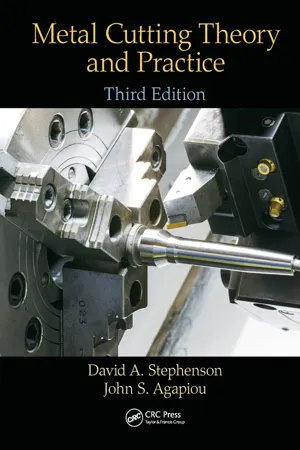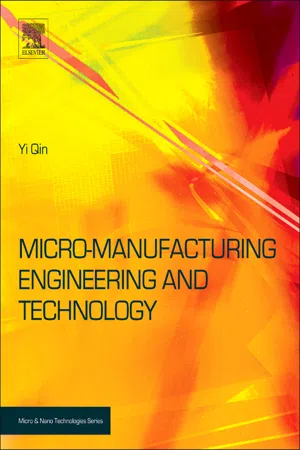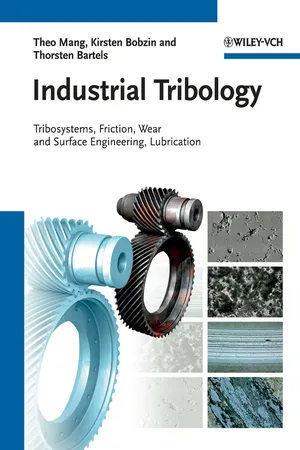Technology & Engineering
Surface Finish
Surface finish refers to the texture or smoothness of a material's outer layer, which is often achieved through processes like grinding, polishing, or coating. It is crucial in engineering and manufacturing as it can affect the functionality, appearance, and performance of a product. Surface finish measurements are used to ensure that the final product meets specific quality standards.
Written by Perlego with AI-assistance
Related key terms
Related key terms
1 of 4
Related key terms
1 of 3
5 Key excerpts on "Surface Finish"
- eBook - ePub
- David A. Stephenson, John S. Agapiou(Authors)
- 2018(Publication Date)
- CRC Press(Publisher)
2 ]. The repeatable portion of the distortion is often not easily eliminated without major changes in the fixture or cutter, but may still be reduced by compensation without major changes. Engineering surfaces manufactured by different processes have different topographies. For example, a milled surface is spatially inhomogeneous, a ground surface may have pits and troughs, and a honed surface has cross-hatched grooves. Such surface features often cannot be modeled analytically; therefore, statistical parameters have traditionally been used to describe their influence on part function. It is important to use the most suitable surface characterization method that links the process to functionality.The first part of this chapter describes methods of measuring and predicting the machined Surface Finish. The measurement of Surface Finish is discussed in Section 10.2 ; the discussion concentrates on stylus-type measurements, which are most common in practice. The Surface Finish in turning, boring, milling, drilling, reaming, and grinding operations is discussed in Sections 10.3 through 10.6 . These sections consider only the texture of the machined surface. Of equal importance in many applications is the surface integrity, which can be defined broadly as the metallurgical and mechanical state of the machined surface. Surface integrity can be assessed using microhard-ness measurements or microstructural analyses, which reveal microcracks, phase transformations, melted and redeposited layers, and similar features. Residual stresses in machined surfaces are discussed in Section 10.7 . White layer formation in steels and surface burning in grinding are considered in Sections 10.8 and 10.9 . Surface integrity is influenced by thermal effects in cutting (Chapter 7 ).Finally, surface flatness measurement is discussed in Section 10.10 , and flatness compensation methods for face-milling operations are described in Section 10.11 .10.2 MEASUREMENT OF Surface Finish
10.2.1 STYLUS MEASUREMENTSThe finish of machined surfaces is most commonly measured with a stylus-type profile meter or profilometer, an instrument similar to a phonograph that amplifies the vertical motion of a stylus as it is drawn across the surface [3 –5 ]. The output of the profilometer is a two-dimensional profile of the traced surface segment, amplified in the directions both normal and along the surface to accentuate surface contours and irregularities (Figure 10.1 ). On a gross scale, the surface profile of a nominally smooth surface gives an indication of the surface’s shape, waviness, and roughness (Figure 10.2 ). The shape of the surface is the macroscopic surface contour. Shape errors may result from errors in the machine tool guideways or machined part, distortions due to clamping forces or subsequent heat treatment, and from tool wear. For nominally flat surfaces, the shape is referred to as the slope or lay of the surface. Waviness refers to variations in the surface with relatively long wavelengths or, equivalently, lower frequencies. Waviness may result from clamping errors, errors in the tool or cutter geometry, or vibrations of the system. As discussed in Section 10.4 , spindle tilt in face-milling operations also produces a waviness or shape error. Roughness - eBook - ePub
- Yi Qin(Author)
- 2010(Publication Date)
- William Andrew(Publisher)
Chapter 14 Surface Engineering and Micro-ManufacturingGonzalo G. FuentesAcknowledgements
The author gratefully acknowledges the support of the European Commission for Research and Development through the FP6 funded project MASMICRO NMP-500095. The Ministry of Education and Science of Spain is also acknowledged through its co-funding action (MAT2007-66550-C2). Finally, the author wishes to acknowledge the support of the Regional Initiative INTERREG IIIB SUDOE for its support on dissemination activities of surface engineering topics, in the frame of the CHESS SO2/1.3/E47 project.Introduction
Surface Engineering
Advanced surface technology or surface engineering is a key knowledge-based sector of great relevance for several manufacturing processes and consumer goods production. Surface engineering encompasses those technologies capable of modifying the surfaces of solids to provide them with superior performance or new functionalities.During recent decades, part of the surface engineering sector has been devoted to the protection of the surfaces of manufacturing tools and industrial components working under severe conditions of friction, wear, oxidation or corrosion. These phenomena are usually considered as catalysts of surface degradation, and yearly they cause huge production costs mainly related to tool reshaping or replacement, as well as component rejection. It is estimated that, in developed economies, surface degradation might cause losses of up to 4% of the GDP. For the USA these features represent approximately $280 billion/year. Moreover, other studies estimate that in Germany alone, the consumption of oil-derived lubricants for wear prevention represents up to $1–2 billion/year [1] - Stephen Emmitt(Author)
- 2018(Publication Date)
- Wiley-Blackwell(Publisher)
10 Surface FinishesFinishes form the interface between building users and the building, and hence affect the way in which we interact and perceive our built environment. Surfaces are seen, touched and smelled by building users. Colour, or the lack of it, affects our perception of space and has an influence on our mood (psychology). Some materials, such as natural timber, give off scent, and this too will influence our reaction to the internal environment. Many materials and finishes also give off pollutants that may negatively affect our health. The focus of this chapter is on applied Surface Finishes to buildings. These are usually applied as a second fix once the main building work is complete. There is a wide variety of applied finishes available. In this chapter, we have confined ourselves to the wall and ceiling finishes most commonly found in domestic properties and small‐office developments. Discussions on finishes associated with commercial buildings, such as raised floors and suspended ceilings, can be found in Barry’s Advanced Construction of Buildings.10.1 Functional requirements
The primary function of a Surface Finish is to provide a durable, visually attractive and low‐maintenance surface to floors, walls and ceilings. There may be differences between the functional requirements of the finish, depending on whether it is an external finish that needs to resist weathering, or an internal finish that needs to resist daily use by the building occupants.External finishes
External finishes are important in determining the aesthetic appeal of the building. The external finishes will also, in conjunction with the detailing and quality of the construction, determine how the building will weather over time. Thus, the quality of the materials used for external finishes and the manner in which they are applied will determine the durability of the building fabric. The functional requirements are:- eBook - ePub
Industrial Tribology
Tribosystems, Friction, Wear and Surface Engineering, Lubrication
- Theo Mang, Kirsten Bobzin, Thorsten Bartels(Authors)
- 2011(Publication Date)
- Wiley-VCH(Publisher)
Chapter 6 Surface EngineeringToday, important industrial sectors such as the automotive industry, the aviation industry and the power engineering industry, depend heavily on modern surface engineering processes. Yet, at the same time, the newer industrial sectors, such as medical engineering, micro-systems technology and micro-electronics, would not have been able to grow as rapidly without the methods of surface engineering. Consequently, approximately two-thirds of all technological innovations are considered attributable to material developments, as the commonly used materials are often no longer able to meet rising demands. Hence, in many industries, new materials with extended functionality and performance limits represent the driving force for new products, and the key to improved competitiveness. The potentials of surface engineering for separately optimizing the volume and surface properties of materials have proven to be both useful and necessary in many fields of engineering, in order to meet the requirements of modern leading-edge technology. The main driving forces behind the spread of surface technologies are the sparing use of resources, environmental protection, and increasing safety requirements. Although the value added by surface engineering and coating industries in Germany alone has been estimated at €20 billion annually [1], it can be assumed that, overall, only 10% of the actual potential of products amenable to surface coating is currently being exploited. It is generally recognized that approximately 85% of all component damage can be attributed to surface attack which, in addition to mechanical attack (such as wear), also includes corrosion . Clearly, a combination of different forms of surface attack is invariably responsible for component damage (Figure 6.1 - eBook - ePub
Fundamentals of Machining Processes
Conventional and Nonconventional Processes, Third Edition
- Hassan El-Hofy(Author)
- 2018(Publication Date)
- CRC Press(Publisher)
9Abrasive Finishing Processes
9.1 INTRODUCTION
The geometric characteristics of machined surfaces affect their wear resistance. In this regard, large surface macro-irregularities result in nonuniform wear, with the projecting peaks of the surface worn off first. In the case of surface waviness, the crests wear down first as the friction and specific pressure will be higher at these than for uniform bearing surfaces of mating parts. Microsurface irregularities are subjected to elastic deformation and crushing or shearing during contact with other sliding surfaces. The valleys between the ridges of a machined surface may be the focus of concentrated internal stresses; these may lead to failure of the machined parts. In case of assembly, the strength of the interference fit also depends on the height of the surface micro-irregularities left by the final machining process. The resistance to corrosion by a liquid, gas, or water depends upon the Surface Finish. The higher the quality, the lower is the area of interaction between the surface and the corrosive medium and, therefore, the improved service life of the machined parts.Surface Finishing is carried out by many machining processes that use abrasives that may be loose or in the form of sticks. Depending on their kinematics and working motions, the following smoothing processes are distinguished:- Honing with long-stroke motions
- Superfinishing with short-stroke oscillatory motions
- Lapping by means of labs
- Polishing by abrasives attached to wheels
- Buffing by loose abrasives supplied to wheels
The main objectives of the aforementioned smoothing processes are to improve surface quality and, only partially, to correct accuracy of shape and dimensions. The machining allowances are of the order of the mean total height of surface irregularities R tm
Index pages curate the most relevant extracts from our library of academic textbooks. They’ve been created using an in-house natural language model (NLM), each adding context and meaning to key research topics.
Explore more topic indexes
Explore more topic indexes
1 of 6
Explore more topic indexes
1 of 4




